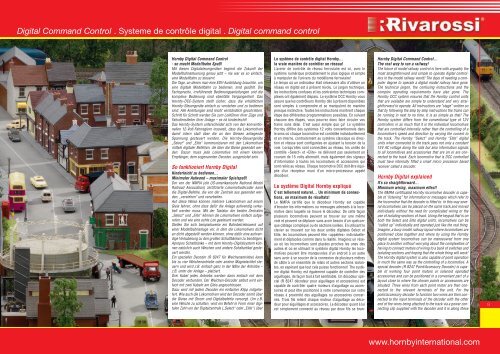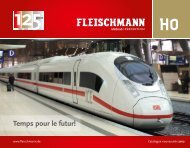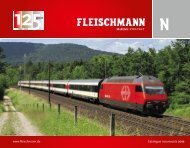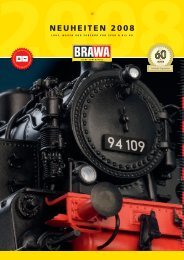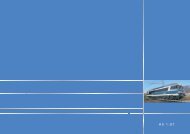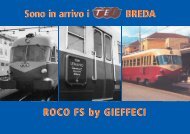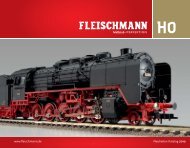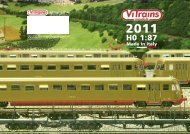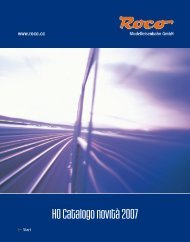Rivarossi
Rivarossi
Rivarossi
You also want an ePaper? Increase the reach of your titles
YUMPU automatically turns print PDFs into web optimized ePapers that Google loves.
Digital Command Control . Systeme de contrôle digital . Digital command control<br />
Hornby Digital Command Control<br />
- so macht Modellbahn Spaß!<br />
Mit diesen Digitalsteuergeräten beginnt die Zukunft der<br />
Modellbahnsteuerung genau jetzt – nie war es so einfach,<br />
eine Modellbahn zu steuern!<br />
Die Tage, an denen man eine EDV-Ausbildung brauchte, um<br />
eine digitale Modellbahn zu bedienen, sind gezählt. Die<br />
Fachsprache, irreführende Bedienungsanleitungen und die<br />
komplexe Bedienung sind ebenfalls Vergangenheit. Das<br />
Hornby-DCC-System stellt sicher, dass die erhältlichen<br />
Hornby-Steuergeräte einfach zu verstehen und zu bedienen<br />
sind. Alle Anleitungen sind leicht verständlich geschrieben.<br />
Schritt für Schritt werden Sie zum Lokführer Ihrer Züge und<br />
Fahrdienstleiter Ihrer Anlage – es ist kinderleicht!<br />
Das Hornby-System unterscheidet sich von den konventionellen<br />
12-Volt-Fahrreglern insoweit, dass die Lokomotiven<br />
damit intern statt über die an den Gleisen anliegende<br />
Spannung gesteuert werden. Die Hornby-Steuergeräte<br />
„Select“ und „Elite“ kommunizieren mit den Lokomotiven<br />
mittels digitaler Befehlen, die über die Gleise gesendet werden.<br />
Dazun muss jede Lokomotive mit einem kleinen<br />
Empfänger, dem sogenannten Decoder, ausgerüstet sein.<br />
So funktioniert Hornby Digital<br />
Kinderleicht zu bedienen…<br />
Minimaler Aufwand – maximaler Spielspaß!<br />
Der von der NMRA (die US-amerikanische National Model<br />
Railroad Association) zertifizierte Lokomotivdecoder kann<br />
die Digital-Befehle, die von der Zentrale aus gesendet werden,<br />
„verstehen“ und verarbeiten.<br />
Auf diese Weise können mehrere Lokomotiven auf einem<br />
Gleis fahren, ohne dass dafür die Anlage aufwendig verkabelt<br />
werden muss. Mit der Tastatur der beiden Zentralen<br />
„Select“ und „Elite“ können die Lokomotiven einfach aufgerufen<br />
und wie eine echte Lok gesteuert werden.<br />
Stellen Sie sich beispielsweise ein Bahnbetriebswerk auf<br />
einer Modellbahnanlage vor, in dem die Lokomotiven dicht<br />
an dicht abgestellt werden können, ohne dafür eine aufwendige<br />
Verkabelung zu den großen Schaltbänken zu benötigen.<br />
Apropos Schaltbänke – mit dem Hornby-Digitalsystem können<br />
natürlich auch Weichen und andere Schaltartikel gesteuert<br />
werden.<br />
Ein spezieller Decoder (R 8247 für Weichenantriebe) kann<br />
bis zu vier Weichenantriebe oder andere Magnetartikel steuern<br />
und wird z.B. einfach ganz in der Nähe der Antriebe –<br />
z.B. unter der Anlage – platziert.<br />
Drei Kabel jedes Antriebs werden dann einfach mit dem<br />
Decoder verbunden. Der Weichen-Decoder selbst wird einfach<br />
mit zwei Kabeln am Gleis angeschlossen.<br />
Dazu wird mit jedem Decoder ein einfacher Klipp mitgeliefert.<br />
Wie auch die Lokomotiven wird der Decoder somit über<br />
die Gleise mit Strom und Digitalbefehle versorgt. Um z.B.<br />
eine Weiche zu schalten, wird ein Befehl in Form einer digitalen<br />
Zahl von der Digitalzentrale („Select“ oder „Elite“) über<br />
Le système de contrôle digital Hornby...<br />
la vraie manière de contrôler un réseau!<br />
L’avenir de contrôle de réseau ferroviaire est ici, avec le<br />
système numérique probablement le plus logique et simple<br />
à manipuler de l’univers du modélisme ferroviaire!<br />
Le temps où un ordinateur était nécessaire afin d’utiliser un<br />
réseau en digital est à présent révolu. Le jargon technique,<br />
les instructions confuses et les contraintes techniques complexes<br />
ont également disparu. Le système DCC Hornby vous<br />
assure que les contrôleurs Hornby dès à présent disponibles<br />
sont simples à comprendre et se manipulent de manière<br />
presque instinctive. Toutes les instructions montrent chaque<br />
étape des différentes programmations possibles. En suivant<br />
chacune des étapes, vous pourrez donc faire circuler vos<br />
trains sans délai. C’est aussi simple que ça! Le système<br />
Hornby diffère des systèmes 12 volts conventionnels dans<br />
le sens où chaque locomotive est contrôlée individuellement<br />
et en interne, contrairement au système classique où direction<br />
et vitesse sont configurées en ajustant la tension de la<br />
voie. Lorsqu’elles sont connectées au réseau, les unités de<br />
contrôle «Select» et «Elite» ne délivrent pas seulement un<br />
courant de 15 volts alternatif, mais également des signaux<br />
d’information à toutes les locomotives et accessoires qui<br />
sont reliés au réseau. Chaque locomotive DCC doit être équipée<br />
d’un récepteur muni d’un micro-processeur appelé<br />
décodeur.<br />
Le système Digital Hornby expliqué<br />
C’est tellement naturel... Un minimum de connections,<br />
un maximum de résultats!<br />
Le NMRA certifie que le décodeur Hornby est capable<br />
d’écouter les informations ou messages adressés à la locomotive<br />
dans laquelle se trouve le décodeur. De cette façon<br />
plusieurs locomotives peuvent se trouver sur une même<br />
voie et peuvent se déplacer sans avoir besoin d’un quelconque<br />
câblage compliqué ou de sections isolées. En utilisant le<br />
clavier se trouvant sur les deux unités digitales Select et<br />
Elite, les locomotives peuvent être «appelées» individuellement<br />
et déplacées comme dans la réalité. Imaginez un réseau<br />
où les locomotives sont placées proches les unes des<br />
autres et où en utilisant le système digital Hornby les locomotives<br />
peuvent être manœuvrées d’un endroit à un autre<br />
sans avoir à se soucier de la connexion de plusieurs mètres<br />
de câble à un ensemble de relais et autres sections isolantes,<br />
en espérant que tout cela puisse fonctionner! The système<br />
digital Hornby est également capable de contrôler des<br />
aiguillages, de façon tout à fait semblable. Un décodeur spécial<br />
(R 8247 décodeur pour aiguillages et accessoires) est<br />
capable de contrôler quatre moteurs d’aiguillage ou accessoires<br />
et peut être positionné à votre convenance sur votre<br />
réseau à proximité des aiguillages ou accessoires concernés.<br />
Trois fils relient chaque moteur d’aiguillage au décodeur<br />
pour aiguillages et accessoires. Le décodeur quant à lui<br />
est simplement connecté au réseau par deux fils se bran-<br />
Hornby Digital Command Control...<br />
The real way to run a railway!<br />
The future of model railway control is here with arguably the<br />
most straightforward and simple to operate digital controllers<br />
in the model railway world! The days of needing a computer<br />
degree to operate a digital model railway have gone.<br />
The technical jargon, the confusing instructions and the<br />
complex operating requirements have also gone. The<br />
Hornby DCC system ensures that the Hornby control units<br />
that are available are simple to understand and very straightforward<br />
to operate. All instructions are “stage” written so<br />
that by following the step by step instructions the trains can<br />
be running in next to no time. It is as simple as that! The<br />
Hornby system differs from the conventional type of 12V<br />
controllers in as much that it is the individual locomotives<br />
that are controlled internally rather than the controlling of a<br />
locomotive’s speed and direction by varying the current to<br />
the track. The Hornby “Select” and Hornby “Elite” digital<br />
units when connected to the track pass not only a constant<br />
15V AC voltage along the rails but also information signals<br />
to all locomotives and accessories that are on or are connected<br />
to the track. Each locomotive that is DCC controlled<br />
must have internally fitted a small micro processor based<br />
receiver called a decoder.<br />
Hornby Digital explained<br />
It’s so straightforward...<br />
Minimum wiring, maximum effect!<br />
The NMRA certificated Hornby locomotive decoder is capable<br />
of “listening” for information or messages which refer to<br />
the locomotive that the decoder is fitted to. In this way several<br />
locomotives can be placed on the same track and moved<br />
individually without the need for complicated wiring or the<br />
use of isolating sections of track. Using the keypad that is on<br />
both the Select and Elite digital unit’s, locomotives can be<br />
“called up” individually and operated just like the real thing.<br />
Imagine, a busy model railway layout where locomotives are<br />
positioned close together and where by using the Hornby<br />
digital system locomotives can be manoeuvred from one<br />
place to another without worrying about the complexities of<br />
having to connect metres of wiring to a bank of switches and<br />
isolating sections and hoping that the whole thing will work!<br />
The Hornby digital system is also capable of point operation<br />
in much the same way as the controlling of a locomotive. A<br />
special decoder (R 8247 Point/Accessory Decoder) is capable<br />
of working four point motors or solenoid operated<br />
accessories and can be positioned in a convenient part of a<br />
layout close to where the chosen points or accessories are<br />
situated. Three wires from each point motor are then connected<br />
to the relevant terminals of the unit. For the<br />
point/accessory decoder to function two wires are then connected<br />
to the input terminals of the decoder with the other<br />
end of the wires being attached to the track via a power connecting<br />
clip supplied with the decoder and it is along these<br />
9<br />
www.hornbyinternational.com


